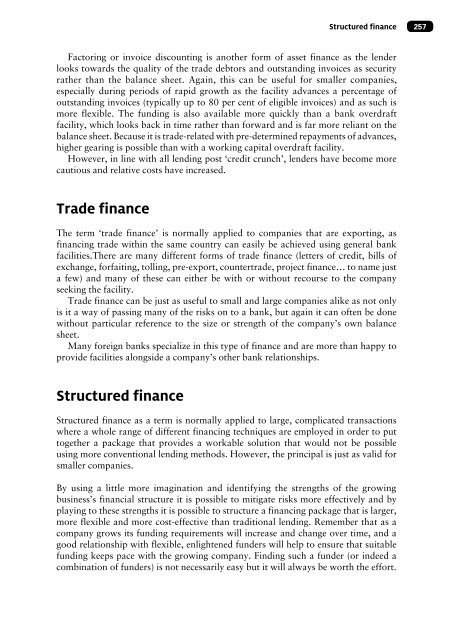The growing business handbook : inspiration and advice ... - Sparkler
The growing business handbook : inspiration and advice ... - Sparkler
The growing business handbook : inspiration and advice ... - Sparkler
Create successful ePaper yourself
Turn your PDF publications into a flip-book with our unique Google optimized e-Paper software.
Structured finance<br />
257<br />
Factoring or invoice discounting is another form of asset finance as the lender<br />
looks towards the quality of the trade debtors <strong>and</strong> outst<strong>and</strong>ing invoices as security<br />
rather than the balance sheet. Again, this can be useful for smaller companies,<br />
especially during periods of rapid growth as the facility advances a percentage of<br />
outst<strong>and</strong>ing invoices (typically up to 80 per cent of eligible invoices) <strong>and</strong> as such is<br />
more flexible. <strong>The</strong> funding is also available more quickly than a bank overdraft<br />
facility, which looks back in time rather than forward <strong>and</strong> is far more reliant on the<br />
balance sheet. Because it is trade-related with pre-determined repayments of advances,<br />
higher gearing is possible than with a working capital overdraft facility.<br />
However, in line with all lending post ‘credit crunch’, lenders have become more<br />
cautious <strong>and</strong> relative costs have increased.<br />
Trade finance<br />
<strong>The</strong> term ‘trade finance’ is normally applied to companies that are exporting, as<br />
financing trade within the same country can easily be achieved using general bank<br />
facilities.<strong>The</strong>re are many different forms of trade finance (letters of credit, bills of<br />
exchange, forfaiting, tolling, pre-export, countertrade, project finance… to name just<br />
a few) <strong>and</strong> many of these can either be with or without recourse to the company<br />
seeking the facility.<br />
Trade finance can be just as useful to small <strong>and</strong> large companies alike as not only<br />
is it a way of passing many of the risks on to a bank, but again it can often be done<br />
without particular reference to the size or strength of the company’s own balance<br />
sheet.<br />
Many foreign banks specialize in this type of finance <strong>and</strong> are more than happy to<br />
provide facilities alongside a company’s other bank relationships.<br />
Structured finance<br />
Structured finance as a term is normally applied to large, complicated transactions<br />
where a whole range of different financing techniques are employed in order to put<br />
together a package that provides a workable solution that would not be possible<br />
using more conventional lending methods. However, the principal is just as valid for<br />
smaller companies.<br />
By using a little more imagination <strong>and</strong> identifying the strengths of the <strong>growing</strong><br />
<strong>business</strong>’s financial structure it is possible to mitigate risks more effectively <strong>and</strong> by<br />
playing to these strengths it is possible to structure a financing package that is larger,<br />
more flexible <strong>and</strong> more cost-effective than traditional lending. Remember that as a<br />
company grows its funding requirements will increase <strong>and</strong> change over time, <strong>and</strong> a<br />
good relationship with flexible, enlightened funders will help to ensure that suitable<br />
funding keeps pace with the <strong>growing</strong> company. Finding such a funder (or indeed a<br />
combination of funders) is not necessarily easy but it will always be worth the effort.








